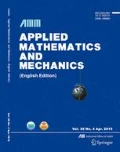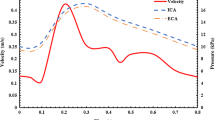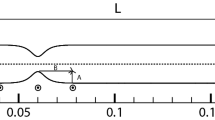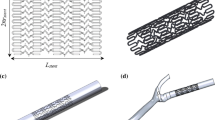Abstract
The targeted drug delivery and targeted drug therapy transport a drug directly to the center of the disease under various conditions and thereby treat it deliberately without effects on the body. This paper studies the magnetic drug targeting (MDT) technique by particle tracking in the presence of magnetic field in bifurcation vessels of a healthy person and a diabetes patient. The Lagrangian particle tracking is performed to estimate particle behavior under effects of imposed magnetic field gradients along the bifurcation. The results show that the magnetic field increases the volume fraction of particle in the target region, and the efficiency of MDT on a patient with the diabetes disease is better than a healthy person. Also, for the higher magnetic numbers, the flow in the upper branch is strongly affected by the magnetic field.
Similar content being viewed by others
References
Lubbe, A. S., Bergemann, C., Riess, H., Schriever, F., and Reichardt, P. Clinical experiences with magnetic drug targeting: a phase study with 4-epidoxorubicin in 14 patients with advanced solid tumors. Cancer Research, 56, 4686–4693 (1996)
Figueroa, C. A., Irene, E. V. C., Jansen, K. E., Hughes, T. J. R., and Taylor, C. A. A coupled momentum method for modeling blood flow in three-dimensional deformable arteries. Computer Methods in Applied Mechanics and Engineering, 195, 5685–5706 (2009)
Torii, R., Oshima, M., Kobayashi, T., and Takagi, K. Fluid structure interaction modeling of blood flow and cerebral aneurysm: significance of artery and aneurysm shapes. Computer Methods in Applied Mechanics and Engineering, 198, 3613–3621 (2009)
Bin, Z., Ying, Z., Li, X., Yang, X., and Huang, D. Comparison of indoor aerosol particle concentration and deposition in different ventilated rooms by numerical method. Building and Environment, 39, 1–8 (2004)
Haverkort, J. W., Kenjeres, S., and Kleijn, C. R. Magnetic particle motion in a Poiseuille flow. Physical review E, 80, 016302 (2009)
Hournkumnuard, K. and Chantrapornchai, C. Parallel simulation of concentration dynamics of nano-particles in high gradient magnetic separation. Simulation Modelling Practice and Theory, 19, 847–871 (2011)
Alexiou, C., Tietze, R., Schreiber, E., Jurgons, R., Richter, H., Trahms, L., Rahn, H., Odenbach, S., and Lyer, S. Cancer therapy with drug loaded magnetic nano-particles magnetic drug targeting. Journal of Magnetism and Magnetic Materials, 323, 1404–1407 (2011)
Nacev, A., Beni, C., Bruno, O., and Shapiro, B. The behaviors of ferromagnetic nano-particles in and around blood vessels under applied magnetic fields. Journal of Magnetism and Magnetic Materials, 323, 651–668 (2012)
Kenjeres, S. Numerical analysis of blood flow in realistic arteries subjected to strong non-uniform magnetic fields. International Journal of Heat and Fluid Flow, 29, 752–764 (2008)
Haverkort, J. W., Kenjeres, S., and Kleijn, C. R. Computational simulations of magnetic particle capture in arterial flows. Annals of Biomedical Engineering, 37, 2436–2448 (2009)
Cherry, E. M. and Eaton, J. K. Simulation of magnetic particles in the bloodstream for magnetic drug targeting applications. ICMF, American Physical Society, Korea, 26–31 (2013)
Kenjeres, S. and Righolt, B. W. Simulations of magnetic capturing of drug carriers in the brain vascular system. International Journal of Heat and Fluid Flow, 35, 68–75 (2012)
Larimi, M. M., Ramiar, A., and Ranjbar, A. A. Numerical simulation of magnetic nano-particles targeting in a bifurcation vessel. Journal of Magnetism and Magnetic Materials, 362, 58–71 (2014)
Akbar, N. S., Nadeem, S., and Khan, Z. H. Numerical simulation of peristaltic flow of a Carreau nanofluid in an asymmetric. Alexandria Engineering Journal, 53, 191–197 (2014)
Kostovaa, V., Antonovaa, N., Velchevab, I., and Ivanova, I. Comparative analysis of the rheological properties of blood in patients with type 2 diabetes. Series on Biomechanics, 27, 80–85 (2012)
Wen, D., Zhang, L., and He, Y. Flow and migration of nano-particle in a single channel. Heat Mass Transfer, 45, 1061–1067 (2009)
Tzirtzilakis, E. E., Sakalis, V. D., Kafoussias, N. G., and Hatzikonstantinou, P. M. Biomag-netic fluid flow in a 3D rectangular duct. International Journal for Numerical Methods in Fluids, 44, 1279–1298 (2004)
He Y. and Zhang, D. W. L. Flow and migration of nanoparticle in a single channel. Heat Mass Transfer, 45, 1061–1067 (2009)
Dahneke, B. Further measurements of the bouncing of small latex spheres. Journal of Colloid and Interface Science, 51, 58–65 (1975)
Brach, R. M. and Dunn, P. F. A mathematical model of the impact and adhesion of microspheres. Aerosol Science and Technology, 16, 51–64 (1992)
Ilic, D., Moix, T., Lambercy, O., Sache, L., Bleuler, H., Ohta, M., and Augsburger, L. Measurement of elastic properties of blood vessels. engineering in medicine and biology. 27th Annual International Conference, 6, 6199–6202 (2005)
Ouglova, A., Francois, Y. M., and Foct, F. Mechanical properties of an iron oxide formed by corrosion in reinforced concrete structures. Corrosion Science, 48, 3988–4000 (2006)
Author information
Authors and Affiliations
Corresponding author
Rights and permissions
About this article
Cite this article
Larimi, M.M., Ramiar, A. & Ranjbar, A.A. Numerical simulation of magnetic drug targeting with Eulerian-Lagrangian model and effect of viscosity modification due to diabetics. Appl. Math. Mech.-Engl. Ed. 37, 1631–1646 (2016). https://doi.org/10.1007/s10483-016-2145-8
Received:
Revised:
Published:
Issue Date:
DOI: https://doi.org/10.1007/s10483-016-2145-8




